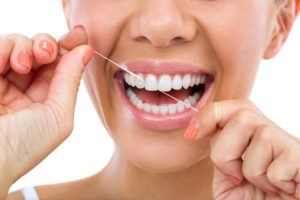
Brushing your teeth twice a day is vital for keeping your teeth and gums healthy. But flossing is every bit as important. In this post, we’ll share some dentist-recommended tips for performing this daily aspect of dental care.
Why Flossing Is So Important
Toothbrushes are great for removing large amounts of plaque from your teeth in a short amount of time. However, they’re not so good at getting into hard-to-reach spots like between and behind your teeth. That’s where floss comes into the picture. By using both products, you can keep your teeth brighter, healthier, and stronger over the long term.
Flossing Basics
The first step is to choose the right type of floss for your teeth. Here are some guidelines to help you in your selection:
- Floss brands vary in terms of thickness. The more compact your teeth, the thinner your floss should be. Thick floss is better suited to people with ample space between their teeth.
- Most flosses are made from either nylon or special monofilament materials. The monofilament types are more expensive, although some people find them easier to use and more effective.
- Whether you use waxed or unwaxed floss is largely a matter of personal preference. One exception applies to people with braces, who should stick with waxed brands.
- It’s always a good idea to use floss that has the ADA seal of approval on the package. You can also ask your dentist to recommend a good brand.
Once you have your floss, you should wind it around your hands till there’s a length of about five inches between them. Take the ends between thumb and forefinger and work the floss side to side between your teeth, not up-and-down.
Make sure you run the floss over the back of each tooth as well. Work slowly and gently until you’re done. You may hear a squeaking sound when you’ve removed as much plaque as possible.
You should check the floss every now and then for nicks or frayed spots. These are signs that the floss you’re using is too thick for your teeth. See your dentist if flossing causes you discomfort or makes your gums bleed. He or she can recommend helpful options.
Flossing Tips for Special Circumstances
- Some people find that holding floss between their fingers is painful or uncomfortable. One solution is to use a flossing stick, which allows for one-handed flossing.
- Having trouble getting your kids to floss? You’ll find sugar-free flavored flosses on the market that can encourage them to form the habit.
- Ask your dentist for guidance if you have a partial denture plate, crowns, bridgework, or implants. He or she may recommend special products or techniques for your situation.
After flossing, it’s a good idea to use a name-brand mouthwash or dental rinse as a finishing touch. This will leave your mouth feeling crisp, clean, and fresh, so you can go out into the world with a smile on your face. Thanks for your interest in taking care of your teeth and gums. We wish you a lifetime of bright, happy smiles.
About the Authors
The good people at MoreSMILES dental spa are devoted to providing a superior dental care experience for their patients. The doctors and staff members are active in both community and global outreach efforts. Your can reach the office online or by calling (985) 888-0668.
